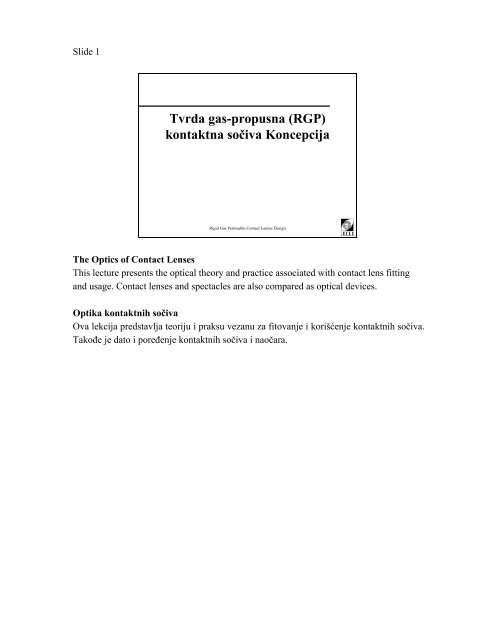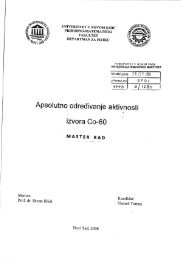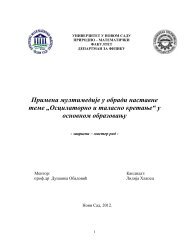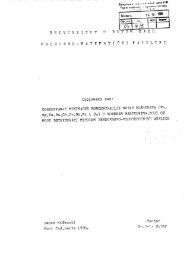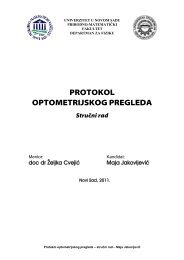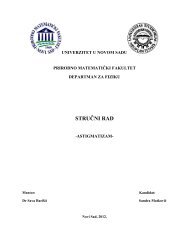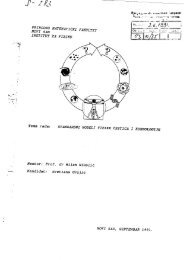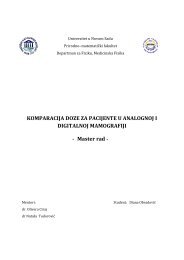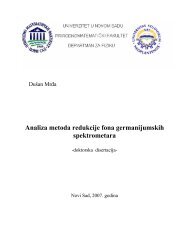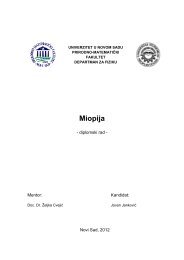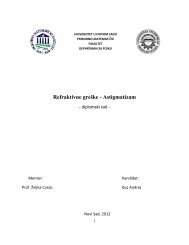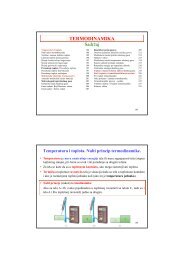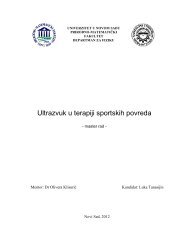Tvrda gas-propusna (RGP) kontaktna sočiva Koncepcija
Tvrda gas-propusna (RGP) kontaktna sočiva Koncepcija
Tvrda gas-propusna (RGP) kontaktna sočiva Koncepcija
Create successful ePaper yourself
Turn your PDF publications into a flip-book with our unique Google optimized e-Paper software.
Slide 1<br />
<strong>Tvrda</strong> <strong>gas</strong>-<strong>propusna</strong> (<strong>RGP</strong>)<br />
<strong>kontaktna</strong> <strong>sočiva</strong> <strong>Koncepcija</strong><br />
Rigid Gas Permeable Contact Lenses Design<br />
The Optics of Contact Lenses<br />
This lecture presents the optical theory and practice associated with contact lens fitting<br />
and usage. Contact lenses and spectacles are also compared as optical devices.<br />
Optika kontaktnih <strong>sočiva</strong><br />
Ova lekcija predstavlja teoriju i praksu vezanu za fitovanje i korišćenje kontaktnih <strong>sočiva</strong>.<br />
Takođe je dato i poređenje kontaktnih <strong>sočiva</strong> i naočara.
Slide 2<br />
Dizajn <strong>RGP</strong> <strong>sočiva</strong><br />
• Glavno za optimizovanje odziva<br />
• Materijali sa visokim Dk omogućavaju dizajn<br />
koji više odgovarajući<br />
Rigid Gas Permeable Contact Lenses Design<br />
Does Design Matter<br />
Design issues can never be ignored because design can be used to optimize the ocular<br />
response both on an individual basis and for the population at large. However, as <strong>RGP</strong><br />
material technology has advanced, <strong>RGP</strong> materials are now much more forgiving in terms<br />
of the precision and finesse of fit required. This is due partially to the generally lower<br />
rigidity of modern <strong>RGP</strong> lens materials.<br />
Da li je dizajn značajan<br />
Dizajn se nikada ne može ignorisati jer se on koristi da bi se optimizovao okularni<br />
odgovor, kako na individualnoj bazi tako na populaciju. Kako se razvijala tehnologija<br />
materijala, <strong>RGP</strong> materijali su danas mnogo više pogodniji u smislu preciznosti i finoće<br />
fitovanja koja se zahteva. To je delom posledica generalno manje tvrdoće modernih<br />
materijala za <strong>RGP</strong> <strong>sočiva</strong>.
Slide 3<br />
<strong>RGP</strong> poželjne osobine<br />
• Optoimalan dizajnOptimal design<br />
• Materijal<br />
• visoki Dk<br />
• vlažljivost<br />
• Otpornost na depozite<br />
• stabilnost<br />
• Laki za proizvodnju<br />
Rigid Gas Permeable Contact Lenses Design<br />
Desirable Properties<br />
The desirable properties of an <strong>RGP</strong> lens are:<br />
Optimal design.<br />
Design is the cornerstone of any contact lens fitting. As materials have improved, the<br />
demands on the prescriber have lessened. However they almost certainly will never be<br />
eliminated, even when topography measuring systems are interfaced to design and<br />
manufacturing systems.<br />
Material.<br />
– Dk.<br />
The minimum requirements for daily wear (DW) and extended wear (EW) can be met by<br />
some <strong>RGP</strong> materials.<br />
– Wettability.<br />
For both optical regularity and lubricity reasons, a wettable material which will retain a<br />
regular tear film is essential for satisfactory ongoing <strong>RGP</strong> lens wear.<br />
– Deposit resistance.<br />
A deposited lens is not only potentially uncomfortable but the wettability and the<br />
regularity of the pre-lens tear film may also be adversely affected.<br />
– Stability. In the interests of maintaining the parameters of the lens, and therefore lens<br />
behaviour, the lens material must be stable.<br />
This enables it to resist changes to its chemistry and properties over time, regardless of its<br />
environment or treatment.<br />
- Ease of manufacture.<br />
Manufacturing difficulties with a particular material can be a barrier to its usage. If<br />
special handling or treatment is required, laboratories may resist using it. Alternatively, if<br />
the material is treated conventionally, an unreliable product may result.
Poželjne osobine<br />
Poželjne osobine su:<br />
Optimalan dizajn.<br />
Dizajn je osnova za svako fitovanje <strong>sočiva</strong>. Kako su se materijali poboljšavali, zahtevi za<br />
prepisivača <strong>sočiva</strong> su se smanjivali, ali oni verovatno nikada neće biti eliminisani, čak ni<br />
kada sistemi za merenje topografije budu povezani sa sistemima za dizajn i proizvodnju.<br />
Materjial.<br />
– Dk.<br />
Neki materijali za RGR zadovoljavaju minimalne zahteve za dnevno nošenje (DW) i za<br />
produženo nošenje (EW)<br />
– Vlažljivost.<br />
OI zbog optičke regularnosti a zbog lubrikacije, vlažljivi materijal treba da zadrži<br />
regularni suzni film jer je to neophodno za zadovoljavajuće korišćenje <strong>sočiva</strong>.<br />
– Dotpornost na depozite.<br />
Sočiva koja primaju depozite (raznu prljavštinu) nisu samo potencijalno nekomforna<br />
nego vlažljivost i regularnost suznog filma pre <strong>sočiva</strong> mogu biti narušeni.<br />
Stabilnost.<br />
U interesu da se zadržavaju parametri <strong>sočiva</strong>, a time i ponašanje <strong>sočiva</strong>, materijal mora<br />
biti stabilan. To omogućava materijalu da bude otporan na promene u hemijii osobina<br />
tokom vremena, bez obzira na okolinu i tretman.<br />
- Laki za proizvodlju.<br />
Teškoće u proizvodnji sa nekim materijalima može biti barijera za njihovu upotrebu. Ako<br />
se zahteva poseban tretman i rukovanje, laboratorije mogu imati otpor prema njihovoj<br />
upotrebi. Ako se takav materijal tretira konvencionalno, može se dobiti nepouzdan<br />
proizvod.
Slide 4<br />
Poželjno fitovanje<br />
• Srednja širina ivice i klirens<br />
• Centralno i srednjeperiferno podešavanje<br />
• Glatko pomeranje<br />
• Centriranje<br />
Rigid Gas Permeable Contact Lenses Design<br />
Desired Fitting<br />
Moderate edge width and clearance.<br />
A balance needs to be struck between the volume of the tear fluid reservoir at the lens<br />
edge and the edge ‘stand-off’ which can adversely affect comfort.<br />
Central and mid-peripheral alignment.<br />
In general, modern <strong>RGP</strong> fitting philosophies are based on alignment with the cornea.<br />
Smooth movement.<br />
Lens movement is essential to disperse metabolic and cellular wastes from under the lens.<br />
Excess movement can create visual and comfort disturbances. A balance of factors<br />
affected by movement will help define the optimal movement characteristics of a fitting.<br />
Adequate centration.<br />
A decentred lens can cause visual anomalies particularly during lowered illumination.<br />
Comfort may also be compromised. Since movement is required, this movement should<br />
be symmetrical about a central location.<br />
Poželjno fitovanje<br />
Srednje širina ivice i klirens.<br />
Potreban je balans gladak između suznog rezervoara na ivici <strong>sočiva</strong> i ivice, da se ne bi<br />
pojavili loši uticaji na komfor.<br />
Podešenost centra i srednje periferije.<br />
Uopšteno, moderna filozofija fitovanja <strong>RGP</strong> je bazirana na podešenosti sa korneom.<br />
Glatko pomeranje.<br />
Smooth movement.<br />
Pomeranje <strong>sočiva</strong> je esencijalno za disperziju metaboličkog i ćelijskog otpada ispod
<strong>sočiva</strong>. Preveliko pokretanje može izazvati vizualne poremećaje i poremećaje u komforu.<br />
Ravnoteža faktora na koje utiče pokretanje pomaže definisanju optimalnih parametara<br />
pomeranja i podešavanja.<br />
Adekvatno centriranje.<br />
Decentrirano sočivo može izazvati vizuelne anomalije posebno pri slabijem svetlu.<br />
Takođe može biti narušen i komfor. Pošto se zahteva pomeranje, ono mora biti<br />
simetrično oko centralne lokacije.
Slide 5<br />
Poželjne performanse<br />
• Komfornost<br />
• Jasan vid<br />
• Odgovarajuće vreme nošenja<br />
• Minimalni okularni odgovor<br />
• Normalan izgled na licu<br />
Rigid Gas Permeable Contact Lenses Design<br />
Desired Performance<br />
A properly performing lens should:<br />
Be comfortable.<br />
Provide clear vision which is equal to or better than the vision provided by spectacle<br />
lenses.<br />
Enable adequate wearing time.<br />
Patient should be able to wear the lenses during waking hours - an acceptable time is<br />
approximately 8-14 hours per day.<br />
Provoke minimal ocular response – lenses usually affect ocular function but the affect<br />
should not be clinically detectable.<br />
Not affect head posture or ocular appearance such as narrowing of the palpebral aperture<br />
or blepharospasm.<br />
Poželjne performanse<br />
Odgovarajuće performase <strong>sočiva</strong>:<br />
Komfornost.<br />
Da obezbede jasan vid, kao i naočare ili čak bolje.<br />
Omogućivanje odgovarajućeg vremena nošenja.<br />
Pacijent mora biti sposoban da <strong>sočiva</strong> nosi za vreme radnog vremena, prihvatljivo vreme<br />
je 8 – 14 sati dnevno.<br />
Izazivanje minimalnog okularnog odgovora – <strong>sočiva</strong> obično utiču na okularnu funkciju<br />
ali taj efekat ne bi trebalo da bude klinički opažljiv.<br />
Da ne remeti položaj glave ili okularnih pojava kao što je sužavanje palpebralne aperture<br />
ili blepharospazma.
Slide 6<br />
Glavne karakteristike dizajna<br />
• Dizajn zadnje površine<br />
• Dijametar zadnje optičke zone<br />
• Dizajn prednje površineFront surface design<br />
• Lens thickness<br />
• Konfiguracija ivice<br />
• Dijametar <strong>sočiva</strong><br />
Rigid Gas Permeable Contact Lenses Design<br />
Perme<br />
On
Slide 7<br />
ISO TERMINOLOGIJA<br />
PARAMETARA SOČIVA<br />
Rigid Gas Permeable Contact Lenses Design<br />
International Organization for Standardization (ISO) terminology is used throughout this<br />
lecture<br />
Terminologija Internationalne Organizacije za Standardizaciju (ISO) se koristi u ovim<br />
predavanjima.
Slide 8<br />
Lens Parameters<br />
Rigid Gas Permeable Contact Lenses Design<br />
Lens Parameters: Front and Back Radii and Thicknesses<br />
Simple Tricurve Lens<br />
The lens parameters, their standardized names and their standardized symbols are<br />
included in this diagram.<br />
r0 = Back Optic Zone Radius<br />
r1 = Back Peripheral Radius (First)<br />
r2 = Back Peripheral Radius (Second)<br />
ra0 = Front Optic Zone Radius<br />
ra1 = Front Peripheral Radius (First)<br />
tc = Geometric Centre Thickness<br />
tpj1 = Peripheral Junction Thickness (First)<br />
tpj2 = Peripheral Junction Thickness (Second)<br />
Parametri <strong>sočiva</strong>: Prednji i zadnji Radijusi i debljina<br />
Jednostavno sočivo sa tri krivine<br />
Parametri <strong>sočiva</strong>, njihovi standardizovani nazivi su prikazani na slici.<br />
r 0 = Radijus zadnje optičke zone<br />
r 1 = Zadnji periferni radijus (prvi)<br />
r 2 = Zadnji periferni radijus (drugi)<br />
r a0 = Radijus prednje optičke zone<br />
r a1 = Prednji periferni radijus (prvi)<br />
t c = Debljina geometrijskog centra<br />
t pj1 = Periferna debljina spoja (prva)<br />
t pj2 = Periferna debljina spoja (druga)
Slide 9<br />
Lens Parameters<br />
Rigid Gas Permeable Contact Lenses Design<br />
Lens Parameters: Diameters and Edge Thicknesses<br />
This diagram shows the relevant diameters along with the two types of edge thickness<br />
defined in the ISO standard.<br />
0 = Back Optic Zone Diameter<br />
o0 = Front Optic Zone Diameter<br />
1 = Back Peripheral Zone Diameter<br />
T = Total Diameter<br />
tER = Radial Edge Thickness<br />
tEA = Axial Edge Thickness<br />
Miscellaneous (not shown on slide)<br />
Fv´ = Back Vertex Power<br />
Fv = Front Vertex Power<br />
Parametri <strong>sočiva</strong>: Dijametri i debljina ivice<br />
Ovaj dijagram pokazuje relevantne dijametre zajedno sa dva tipa debljine ivice definisane<br />
u ISO standardu..<br />
ø 0 = Dijametar zadnje optičke zone.<br />
ø o0 = Dijametar prednje optičke zone<br />
ø 1 = Dijametar zadnje periferne zone<br />
ø T = Ukupni dijametar<br />
t ER = Debljina radijalne ivice<br />
t EA = Debljina aksijalne ivice<br />
Razno (nije prikazano na slajdu)<br />
F v´ = Jačina zadnjeg verteksa<br />
F v = Jačina prednjeg verteksa
Slide 10<br />
Zadnja površina<br />
• Kontroliše interakciju sočivo/kornea<br />
•Utiče na<br />
Centriranje<br />
Pokretanje<br />
Rigid Gas Permeable Contact Lenses Design<br />
The Back Surface<br />
Back surface design (shape) is the major factor in controlling the lens/cornea interaction.<br />
This interaction largely controls the clinical behaviour of a lens which is usually<br />
described as the ‘fit’.<br />
This lens/cornea interaction affects the centration of the lens as well as lens movement.<br />
Since lens ‘fit’ is more than just the result of a lens being steeper, flatter or aligned with<br />
the cornea, the back surface design outside the back central optic zone is also relevant to<br />
final lens behaviour.<br />
Zadnja površina<br />
Dizajn zadnje površine (oblik) je glavni faktor za kontrolu interakcije sočivo/kornea. Ova<br />
interakciju u mnogome kontroliše kliničko ponašanje <strong>sočiva</strong> koje obično naziva “fit”<br />
Interakcija sočivo/kornea utiče na centriranost <strong>sočiva</strong> i na pokretanje. S obzirom da je<br />
“fit” više od toga da sočivo sa većim nagibom, ili je ravnije, ili je u liniji sa korneom,<br />
dizajn zadnje zone van zaddnje centralne optičke zone je takođe bitan na konačno<br />
ponašanje <strong>sočiva</strong>.
Slide 11<br />
Dizajn sa više krivih<br />
Rigid Gas Permeable Contact Lenses Design<br />
Multicurve Design<br />
This diagram illustrates a series of spherical (i.e. shapes based on a circle) back curves<br />
which will ultimately be blended to form a smooth continuous curve. Importantly,<br />
because spherical surfaces are the result of the use of a conventional lathe, the centres of<br />
curvature of each of these spherical curves lies on the axis of symmetry of the lens<br />
(which is also the optic axis of such a lens).<br />
Dizajn sa više krivih<br />
Dijagram ilustruje seriju sferičnih (tj. Oblika baziranih na krugu) zadnjih krivih koje se<br />
konačno stapaju i formiraju glatku kontinualnu krivu. Važno je, jer su sferične površine<br />
rezultat konvencionalnog struganja, da centri krivina svake od tih krivih leži na osi<br />
simetrija <strong>sočiva</strong> (koja je istovremeno i optička osa <strong>sočiva</strong>).
Slide 12<br />
Kontinualni ne-sferčni dizajn<br />
• Jedna kontinualna kriva<br />
• Aproksimira oblik kornee<br />
• Asferična<br />
• Oblik se obično dobija iz konusnih preseka<br />
• Više od jednog konusnog preseka se koristi da<br />
bi se dobila kontinualna kriva<br />
Rigid Gas Permeable Contact Lenses Design<br />
Continuous Non-Spherical Design<br />
Surface designs (front or back) don’t have to be limited to designs based on a circle. The<br />
concept of the cornea not being spherical has been accepted for more than a century<br />
(Senff, 1846).<br />
The attraction of a continuous single curve which more nearly approximates the cornea’s<br />
actual shape is obvious. Such surface designs are referred to as ‘aspheric’ and represent a<br />
deliberate attempt to improve on designs which are ‘spherical’. (The term ‘spheric’ is not<br />
normally used but is still correct.)<br />
The family of curves from which such surface shapes can be derived, which also includes<br />
a first order approximation to the shape of the cornea, is called conic sections.<br />
Conic sections can be combined to form compound continuous curves. Combinations of<br />
conic and nonconic sections have also been used. The advent of computers and computeraided<br />
manufacturing means that very complex continuous curves are possible.<br />
Kontinualni ne-sferčni dizajn<br />
Dizajn površine (prednje ili zadnje) ne mora biti ograničen samo na krugu. Oblik kornee<br />
nije sferni što je ustanovljeno pre više od jednog veka (Senff, 1846).<br />
Privlačnost jedne kontinualne krive koja vrlo blisko aproksimira oblik kornee je<br />
očigledna. Takav oblik je asferični i predstavlja promišljen pokušaj da se popravi sferični<br />
dizajn (Izraz “sferni” normalno ne koristi iako je korektan.<br />
Familija krivih od kojih se može dobiti oblik površine, što takođe uključuje prvu<br />
aproksimaciju oblika kornee, se zove konusni preseci.<br />
The family of curves from which such surface shapes can be derived, which also includes<br />
a first order approximation to the shape of the cornea, is called conic sections.<br />
Konusni preseci se mogu kombinovati da bi se dobila složena kontinualna kriva. Takođe<br />
se može koristiti i kombinacija konusnih i ne-konusnih preseka. Korišćenje kompjutera<br />
omogućava vrlo kompleksne kontinualne krive.
Slide 13<br />
Konusni preseci<br />
Rigid Gas Permeable Contact Lenses Design<br />
Conic Sections<br />
This diagram shows all conic sections. In this series the circle is considered a special case.<br />
The hyperbola has been rarely used in <strong>RGP</strong> or PMMA lenses and it is believed that no<br />
current lens designs incorporate such a shape. The solid formed by the rotation of a conic<br />
section about its major axis is called a conicoid. The conicoid resulting from the special<br />
case of the circle is a sphere hence the term spherical.<br />
Konusni preseci<br />
Ovaj dijagram prikayuje sve konusne preseke. U ovom niyu, krug predstavlja poseban<br />
slu;aj. Hiperbola se retko koristi kod <strong>RGP</strong> ili PMMA so;iva i veruje se da takav način<br />
kombinacije kod <strong>sočiva</strong> koji to uključuje se ne koristi. Čvrsti deo koji se formira<br />
rotacijom konusnog preseka oko glavne ose se zove konisoid. Konisoid koji je rezultat od<br />
specijalnog slučaja kruga je sfera odatle potičeizraz sferični.
Slide 14<br />
Prvi pravi asferični dizajn tvrdih <strong>sočiva</strong><br />
(Feinbloom, 1961)<br />
• Elipsoidna, PMMA, Sfere i Torična<br />
• Uvedena je i oprema za proizvodnju<br />
• Dalji razvoj – Volk.<br />
Volk je postao najizraženiji promoter asferika<br />
(1961 - 1987)<br />
Rigid Gas Permeable Contact Lenses Design<br />
First True Aspheric Hard Lens Design<br />
The first true aspheric hard lens design was by Feinbloom in 1961. His lens was<br />
ellipsoidal and could be fabricated as a lens with either a spherical or a toric Rx. Because<br />
the shapes could not be generated by contemporary equipment, Feinbloom also invented<br />
fabrication machinery for the generation of his lens designs. His pioneering work was<br />
quickly followed by the work of Volk and Neefe. The former then went on to become the<br />
greatest proponent of aspheric lenses for contact lenses and virtually all other clinical<br />
purposes (e.g. field lenses for indirect ophthalmoscopy).<br />
First True Aspheric Hard Lens Design<br />
Prvi pravi dizajn asferičnih tvrdih <strong>sočiva</strong> je uradio Feinbloom 1961. Njegova <strong>sočiva</strong> su<br />
bila elipsoidna i mogla su se proizvoditi kao sferična ili torična Rx. Zbog toga što se tada<br />
ta <strong>sočiva</strong> nisu mogla proizvoditi sa postojećim mašinama Feinbloom je izumeo mašinu za<br />
takva <strong>sočiva</strong>.Njegov pioniski rad su vrlo brzo pratili Volk i Neefe. Prvi je postao najveći<br />
promoter aaferičnih <strong>sočiva</strong> i verovatno svih kliničkih primena )tj. Sočiva za indirektnu<br />
oftalmolmoskopiju).
Slide 15<br />
Asferični dizajni<br />
• Regularne nesferične krive na zadnjoj površini<br />
• Često su kintinualne krive<br />
• Centri krivine su van ose simetrije<br />
Rigid Gas Permeable Contact Lenses Design<br />
Aspheric Designs<br />
Aspheric lenses incorporate regular non-spherical curves whose centres of curvature<br />
appear to be off the axis of symmetry (cf. spherical lens designs whose centres of<br />
curvature appear to be on the axis of symmetry).<br />
Surfaces, especially back surfaces, are often a continuous curve as opposed to surfaces<br />
formed by blending discrete curves.<br />
Asferični dizajni<br />
Asferična <strong>sočiva</strong> uključuju pravilne nesferične krive čiji se centri krivine nalaze van ose<br />
simetrije (kod sferičnog dizajna centar krivine je na osi simetrije). Površine, pogotovo<br />
zadnje površine su kontinualne krive za razliku od krivih koje su napravljene od više<br />
krivih i koje se stapaju u jednu.
Slide 16<br />
Krug protiv elipse<br />
Asferične površine<br />
Rigid Gas Permeable Contact Lenses Design<br />
Aspheric Surfaces<br />
Despite the dramatic diagrams used to illustrate aspheric surfaces and curves which<br />
appear in textbooks, the shape differences are anything but dramatic. This diagram<br />
compares a circle and an ellipse. Despite the ellipse’s larger than normal eccentricity (0.9<br />
versus 0.4 to 0.6), and the use of a larger than practical diameter, the difference,<br />
especially over a more realistic aperture of say 8 mm, in fact remains quite small.<br />
Asferične površine<br />
Uprkos dramatičnim dijagramima koji se pojavljuju u knjigama u kojima se porede<br />
asferne površine i sferne, ništa se drugo ne pokazuje osim dramatičnosti. Ovaj dijagram<br />
poredi krug i elipsu. Uprkos ekscentriteta elipse većeg od normalnog (o.9 u odnosu na 0.4<br />
do 0.6), i korišćenjem većeg pečnika, razlika, pogotovo za realističnije aperture od oko 8<br />
mm, u stvari su jako male.
Slide 17<br />
Dizajn zadnje površine:<br />
Sloboda u dizajnu<br />
• Sferični i asferični<br />
• Jedna ili više krivih<br />
• Odnos sa fitovanjem<br />
Rigid Gas Permeable Contact Lenses Design<br />
Back Surface Design: Design Freedom<br />
While back surface design is somewhat limited by the fact that it must relate to the<br />
corneal shape in an acceptable way, there is still some freedom as to the final overall<br />
shape. The possibilities are:<br />
A spherical or aspheric shape.<br />
Single or multiple curve design.<br />
Fitting relationships which broadly fall into the following categories:<br />
steeper than the cornea<br />
aligned with the cornea<br />
flatter than the cornea.<br />
Dizajn zadnje površine:<br />
Sloboda u dizajnu<br />
Iako je dizajn zadnje površine delimično ograničen činjenicom da oblik mora biti<br />
odgovarajući obliku kornee, ipak postoji izvesna sloboda u konačnom obliku. Te<br />
mogućnosti su:<br />
Sferični ili asferični oblik.<br />
Dizajn sa jednom ili više krivih.<br />
Odnos sa fitovanjem koje se može podeliti u sledeće kategorije:<br />
strmiji nego korneathan the cornea<br />
U liniji sa korneom<br />
Ravniji od kornee.
Slide 18<br />
Dizajn zadnje površine:<br />
Cliničko razmatranje<br />
• Centralni model fluoresceinom<br />
• Promene u krivini kornee<br />
• Viđenje<br />
Rigid Gas Permeable Contact Lenses Design<br />
Back Surface Design: Clinical Considerations<br />
Central fluorescein pattern.<br />
The use of sodium fluorescein is a sensitive technique for comparing the cornea’s shape<br />
to that of a trial contact lens by highlighting the differences between them.<br />
Corneal curvature changes.<br />
When a fitting relationship other than alignment is chosen, the possibility that the lens<br />
may alter the corneal curvature and/or shape needs to be considered.<br />
Lens adherence.<br />
Virtually all EW <strong>RGP</strong> wearers will show an episode of lens adherence at some time and it<br />
is still not clear what, if anything, can be done to eliminate the occurrence.<br />
Vision.<br />
If the corneal shape is normal and regular, the tear lens power, and its influence on the<br />
final BVP required, is directly influenced by the BOZR chosen. If the cornea is irregular,<br />
keratoconic or highly astigmatic, the overall back surface shape, as well as the BOZR,<br />
may influence the vision outcome.<br />
Dizajn zadnje površine:<br />
Cliničko razmatranje<br />
Centralni model fluoresceinom.<br />
Korišćenje natrijumovog fluoresceina je osetljiva tehnika za poređenje oblika kornee sa<br />
oblikom probnog <strong>sočiva</strong> tako što su oblasti gde postoje razlike svetlije.<br />
Promene u krivini kornee<br />
Kada se izabere neki drugi način fitovanja od potpuno podešenog, postoji mogućnost ta<br />
sočivo menja krivinu kornee.
Prilepljenost <strong>sočiva</strong>.<br />
U principu svi nosioci <strong>RGP</strong> <strong>sočiva</strong> će osetiti nekad prilepljenost <strong>sočiva</strong>, i još nije jasno<br />
šta se može učiniti da se ta pojava eliminiše.<br />
Viđenje.<br />
Ako je oblik kornee normnalan i pravilan na vidjenje direktno utiče odabrani BOZR<br />
Ako je kornea nepravilna, keratonična ili jako astigmatična. Celokupna zadnja površina,<br />
ako i BOZR utiču na vidjenje.
Slide 19<br />
Fluoresceinski model<br />
Rigid Gas Permeable Contact Lenses Design<br />
Fluorescein Pattern<br />
The fluorescein pattern observed under an <strong>RGP</strong> lens depends on its back surface shape.<br />
The diagrams, representing cross-sectional traces of tear lens thickness under rigid lenses,<br />
show the expected patterns from two possibilities.<br />
An aspheric shape ideally aligns with the cornea. As a result, little or no fluorescein is<br />
seen anywhere except at the lens edge. The latter is due to the tear reservoir/meniscus<br />
deliberately formed at the lens edge.<br />
A spherical BOZD shows the effect of a spherical curve not aligning with the aspheric<br />
cornea. The bull’s-eye appearance refers to the concentric bright band (ring of<br />
fluorescence) surrounding the dark centre (absence of fluorescence) which results. This<br />
effect is much less pronounced with a small BOZD) even when the BOZR is altered to<br />
compensate for the change in sagittal height.<br />
Fluoresceinski model<br />
Floresceinski model koji se vidi ispod <strong>RGP</strong> <strong>sočiva</strong> zavisi od oblika zadnje površine.<br />
Dijagrami predstavljaju poprečne preseke debljine šupljina ispod tvrdog <strong>sočiva</strong><br />
pokazujući dve mogućnosti.<br />
Asferični oblik idealno naleže na korneu. Kao rezultat, malo ili upšte se nevidi<br />
fluorescein, osim na ivici. Na ivicama se vidi zbog suza/meniskusa koji se formira na<br />
ivici <strong>sočiva</strong>.<br />
Sferični BOZD pokazuje efekat da sferna krivina ne naleže potpuno na asfernu korneu.<br />
Pojava oka bika se ogleda u koncentričnim trakama (prsten fluoresceina) koji opkoljava<br />
tamni centar (odsustvo fluoresceina). Ovaj efekat je manje primetan za mali BOZD.
Slide 20<br />
Diagram of the<br />
Three Main Fitting Philosophies<br />
Rigid Gas Permeable Contact Lenses Design<br />
Diagram of the Three Main Fitting Philosophies<br />
Flatter.<br />
Aligned.<br />
Steeper.<br />
Dijagram tri glavne filozofie fitovanjaDiagram of the Three Main Fitting<br />
Philosophies<br />
Ravniji.<br />
Naleganje.<br />
Sa većom strminom.
Slide 21<br />
Radijus zadnje optičke zone<br />
• Asferični<br />
• Bolje ležanje<br />
• Teži za proizvodnju<br />
• Teški za kontrolu<br />
•Veća decentracija<br />
• Sferični<br />
• Bolje viđenje<br />
• Bolja centracija<br />
Rigid Gas Permeable Contact Lenses Design<br />
Back Optic Zone Radius:<br />
Aspheric:<br />
– better alignment. Cornea is aspheric and better approximations to its shape can be<br />
achieved with aspheric back surface designs.<br />
– difficult to manufacture. While the difference between spherical and aspheric lenses is<br />
now smaller due to the wide usage of CNC lathes, it is still slightly more difficult to<br />
produce aspheric lenses by nonmolding techniques. Molding aspherics is only more<br />
difficult at the start-up stage when master tools are being fabricated.<br />
– difficult to verify. Since current instruments are designed for spherical optics and<br />
curves, aspherics represent a challenge to both the industry and practitioners.<br />
Spherical:<br />
– studies have shown that spherical surface shapes generally produce superior vision<br />
quality (see slide 25).<br />
Radijus zadnje optičke zone :<br />
Asferični:<br />
– bolje naleganje. Kornea je asferična tako da se bolja aproksimacija može postići sa<br />
asferičnim dizajnom zagnje površine.<br />
– Teški za proizvodnju. Iako je razlika u težini izrade sferičnih i asferičnih <strong>sočiva</strong> danas<br />
manja zahvaljujući CNC strugovima, ipak je malo teža proizvodnja asferičnih površina<br />
tehnikama nelivenja. Tehnika livenja je komplikovanija samo u početkudok se ne napravi<br />
glavni alat.<br />
– teški za proveru. Zato što su instrumenti za kontrolu napravljeni za sfernu optiku i krive,<br />
asferični su izazov i industriju i praktičara.<br />
Sferični:<br />
– studije su pokazale da sferični oblici daju bolji kvalitet vida (vidi slajd 25)
Slide 22<br />
Promene kornealne krivine<br />
Efekt filozofije fitinga<br />
(n=11)<br />
SFERIČNI<br />
K h -0.26 + 0.49 D<br />
K v -0.61 + 0.47 D<br />
ASFERIČNI<br />
-0.19 + 0.51 D<br />
-0.20 + 0.47 D<br />
p
Slide 23<br />
Efekat filozofija fitovanja<br />
Sferični dizajn zadnje površine<br />
K h<br />
Steep +0.04 (0.42 D)* -0.15 (0.54 D)*<br />
Align -0.03 (0.43 D)* -0.23 (0.52 D)*<br />
Flat -0.13 (0.39 D)* -0.32 (0.59 D)*<br />
K v<br />
p
Slide 24<br />
Bearing Relation Range<br />
Bearing Rotation Range<br />
Rigid Gas Permeable Contact Lenses Design 24<br />
Lens Adherence: Bearing Relation Range<br />
When the relationship between <strong>RGP</strong> lens adherence (lens binding to the cornea) and the<br />
fitting relationship is examined, it appears that when the lens is fitted steeper than K, the<br />
incidence of adherence is lower but still not zero. While adherence with ‘aligned’ and<br />
‘flatter’ fits differs little, there is a tendency for the flatter fits to result in a greater<br />
incidence of adherence.<br />
Lens Adherence: Bearing Relation Range<br />
Kada se razmatra odnos izmedju prijanjanja <strong>RGP</strong> <strong>sočiva</strong> (vezivanje za korneu)i fitovanja,<br />
izgleda kada se fituju <strong>sočiva</strong> sa većim nagibom od K, incidenca prijanjanja je manja, ali<br />
nije nula. Iako se prijanjanje kod druga dva slučaja ne razlikuje puno, vidi se da je<br />
tendencija incidence prijanjanja veća za ravniji fit.
Slide 25<br />
Dizajn tvrdih <strong>sočiva</strong><br />
(Cornish, 1987)<br />
Rigid Gas Permeable Contact Lenses Design<br />
Rigid Lens Design and Vision Quality<br />
The effect of back surface shape on vision quality is demonstrated in this graph. While<br />
spherical and elliptical shapes produced little loss of quality, a combination of them<br />
resulted in a greater decrease in vision. For manufacturing convenience, <strong>RGP</strong> lenses with<br />
aspheric back surface designs often have spherical front surfaces, a combination this<br />
graph suggests is undesirable. The parabolic surface shape performed poorly.<br />
Dizajn tvrdih <strong>sočiva</strong> i kvalitet vida<br />
Efekat zadnje površine na kvalitet vida je demonstriran na grafiku. Dok sferični i eliptični<br />
oblik izazivaju mali gubitak vida, njihova kombinacija izaziva veći gubitak. Zbog<br />
pogodnosti za proizvodnju, <strong>RGP</strong> <strong>sočiva</strong> sa asferičnom zadnjom površinom često imaju<br />
sferičnu prednju površinu, čiju kombinacija se na osnovu grafika ne predlaže.<br />
Parabolična površina se ponaša loše.
Slide 26<br />
Efekat (uticaj) BOZD na viđenje<br />
Rigid Gas Permeable Contact Lenses Design<br />
Vision Effect of Back Optic Zone Diameter<br />
The effects on vision of a BOZD (0) which is smaller than the entrance pupil size (the<br />
image of the anatomical pupil formed by the optics of the cornea and anterior chamber)<br />
are illustrated in this diagram. Once the BOZD is exceeded by the entrance pupil<br />
diameter, light is refracted by the optic zone, the first curve junction and the lens<br />
periphery. In this circumstance, vision quality, including image contrast, is decreased.<br />
Efekat dijametra zadnje optičke zone na viđenje<br />
Efekat BOZD ( 0 ) koji je manji od ulazne veličine zenice na viđenje (lik anatomske<br />
zenice se formira optikom kornee i prednjom komorom) je ilustrovano na slici. Pošto je<br />
ulazni dijametar zenice veći od BOZD, svetlost se prelama u optičkoj zoni, prvom<br />
spojem krive i periferijom <strong>sočiva</strong>. Pri takvim uslovima, kvalitet vida, uključujući i<br />
kontrast lika, se smanjuje.
Slide 27<br />
Optimalni dizajn zadnje površine:<br />
Pregled<br />
• K se menja u skladu sa odnosom fitovanja<br />
• Sočiva sa velikom kosinom<br />
• Labije prijanjanje<br />
• Veći optički dijametar<br />
• Bolje viđenje ali slabije podešavanje<br />
Rigid Gas Permeable Contact Lenses Design<br />
Optimal Back Surface Design: Summary<br />
Assuming the lens back surface design is spherical and an alignment fitting is sought, the<br />
following summarizes the optimum fluorescein fitting pattern of a centred <strong>RGP</strong> contact<br />
lens resting on a spherical cornea:<br />
Alignment or a very slight tendency towards apical clearance over the central 7 – 8 mm.<br />
Mid-peripheral alignment about 1 – 2 mm wide.<br />
Edge clearance about 0.5 mm wide.<br />
An obvious tear meniscus at the lens edge. The actual dimensions (pattern widths)<br />
depend on:<br />
Total lens diameter (TD).<br />
Corneal topography (toricity, p-value and regularity).<br />
Actual lens back surface design (including BOZD, etc.).<br />
Optimalni dizajn zadnje površine: Pregled<br />
Pretpostavljajući da je zadnja površina sferična i da sezahteva podešeni fiting, sledeće<br />
sumira optimalni fluoresceinski model centriranog <strong>RGP</strong> kontaktnog <strong>sočiva</strong> na sferičnoj<br />
površini:<br />
Podešenost ili vrlo mali pomak ka apikalnom klirensu preko centralnog 7 – 8 mm<br />
Srednje-periferno podešavanje širine oko 1 – 2 mm<br />
Ivični klirens oko 0.5 mm<br />
Očigledni suzni meniskus na ivici <strong>sočiva</strong>. Aktuelne dimenzije (širine modela) zavise od:<br />
Ukupnog dijametra <strong>sočiva</strong> (TD)<br />
Kornealne topografije (toričnosti, p-vrednosti i pravilnosti)<br />
Aktuelnog dizajna zednje površine <strong>sočiva</strong> (uključujuđi BOZD i drugo)
Slide 28<br />
Zadnja površina srednja periferija<br />
Sloboda u dizajnu<br />
• Širina<br />
• Radijus<br />
• Oblik<br />
• Broj krivih<br />
Rigid Gas Permeable Contact Lenses Design<br />
Back Surface Mid-Periphery<br />
Design Freedom:<br />
Width. The width of the curve(s).<br />
Radius. The radius/radii of the curve(s).<br />
Shape. The shape or form of the surface, i.e. conical, spherical, aspheric.<br />
Number of curves.<br />
Zadnja površina srednja periferija<br />
Sloboda u dizajnu:<br />
Širina krive - krivih<br />
Radijus ili radijusi krive-krivih<br />
Oblik ili forma površine, tj. Konična, sferična, asferična.<br />
Broj krivih
Slide 29<br />
Zadnja površina srednja periferija<br />
Zahtev:<br />
Treba da se poravna sa ravnajućom<br />
korneom.<br />
Uticaji:<br />
Stabilnost fita.<br />
Suzni tok.<br />
Oblik kornealne periferije<br />
Centriranje.<br />
Rigid Gas Permeable Contact Lenses Design<br />
Back Surface Mid-Periphery<br />
Requirement:<br />
Should align flattening cornea. Since the cornea flattens peripherally, the lens secondary<br />
and peripheral zones must have curves which are flatter than the BOZR, preferably<br />
flattening progressively. This can be achieved by a series of flattening blended spherical<br />
curves, or by a continuous aspheric curve such as an ellipsoid or a paraboloid which<br />
would match the corneal shape.<br />
Affects:<br />
Stability of fit.<br />
If the mid-peripheral curves are significantly flatter than this corneal region, excessive<br />
clearance, an unstable fit and excessive movement will result.<br />
Tear flow.<br />
This area of the lens can cause a restriction of tear flow if the bearing area is localized<br />
(narrow) by sealing off the back optic zone region. This is also likely to produce a tight<br />
fit and entrapment of debris or air bubbles within the optic zone area.<br />
Corneal peripheral shape.<br />
As with the central region, corneal shape can be affected by the lens fitting relationship.<br />
Harsh and localized bearing on the mid-peripheral band may cause corneal indentation.<br />
Centration.<br />
If the mid-peripheral zone is flatter than the cornea resulting in excessive edge lift, the<br />
lens is more likely to decentre.<br />
Zadnja površina srednja periferija<br />
Zahtev:
Treba da se poravna sa ravnajućom korneom. Pošto se kornea izravnava ka periferiji,<br />
sekundarna i periferne zone <strong>sočiva</strong> moraju biti krive koje su ravnije nego BOZR, po<br />
mogućnosti izravnavanje treba da bude progresivno.Ovo se može postići stapanjem niza<br />
sferičnih krivih koje se izravnavaju, ili kontinualnom asferičnom krivom kao što je<br />
elipsoid ili paraboloid koji pašu na oblik kornee.<br />
Uticaji:<br />
Stabilnost fita.<br />
Ako su srednje periferne krive ravnije nego ta oblast kornee, pojavljuje se povećani<br />
klirens, nestabilni fit i veće pomeranje.<br />
Suzni tok.<br />
Ova oblast <strong>sočiva</strong> može uzrokovati restrikciju suznog toka ako je oblast nošenja<br />
lokalizovana blokiranjem oblašću zadnje optičke zone.To će verovatno prouzrokovati<br />
čvrst fit i zarobljavanje nekih krhotina ili vazdučnih mehurića unutar oblasti optičke zone.<br />
Oblik kornealne periferije<br />
Corneal peripheral shape.<br />
Kao i centralni region, kornealni oblik moze biti povezan ifitovanjem sočia. Grubo i<br />
lokalizovano nošenje na traci srednje periferije može izazvati kornealni lom.<br />
Centriranje.<br />
Akoje srednja periferna zona ravnija od kornee rezultujući u znatnom podizanju ivice,<br />
sočivo će se verovatno decentrirati.
Slide 30<br />
Centralni fit i srednja periferija (MP)<br />
Centar sa velikim nagibom<br />
Tesna MP<br />
Poravnat<br />
Ili ravan centar<br />
Umeren do ravan<br />
klirens MP<br />
Rigid Gas Permeable Contact Lenses Design<br />
Central Fit and Mid-Periphery<br />
A steep central fit may produce a tight midperipheral fit unless multiple curves are used<br />
and the optic zone diameter is reduced. An aligned or flat central fit can result in<br />
moderate or excessive mid-peripheral clearance.<br />
Centralni fit i srednja periferija<br />
Kosi centralni fit može proizvesti tesan srednje periferni fit ukoliko nije korišćeno više<br />
krivih i ako je dijametar optičke zone smanjen. Poravnat ili ravan centralni fit može<br />
rezultovati u srednjem ili znatnom srednje periferijskom klirensu.
Slide 31<br />
Rigid Gas Permeable Contact Lenses Design<br />
Axial Edge Lift, Radial Edge Lift, Tear Layer Thickness<br />
This diagram illustrates the terms Axial and Radial Edge Lift and Clearance as well as<br />
the Tear Layer Thickness (TLT). While this diagram refers to the lens edge, the concept<br />
of the ‘extension’ of the base curve (BOZR) to form a reference surface applies to all lens<br />
zones, i.e. central, mid-peripheral, peripheral and edge zones. Note that the term ‘lift’<br />
refers to a lens and not the lens/cornea fitting relationship. The terms axial and radial<br />
clearance are used to describe the distance between the lens and the cornea for each of<br />
the lens zones.<br />
Aksijalno podizanje ivice. Radijalno podizanje ivice. Debljina suznog filma<br />
Ovaj dijagram ilustruje izraze Aksijalno podizanje ivice, Radijalno podizanje ivice i<br />
Debljina suznog filma (TLT). Ovaj dijagram se odnosi na ivicu <strong>sočiva</strong>, koncept<br />
“ekstenzije” bazne kriva (BOZR) da referentnu površinu se primenjuje na sve zone, tj<br />
centralnu, srednje perifernu i ivičnu. Izraz “podizanje” se odnosi na sočivo a ne na odnos<br />
fita sočivo/kornea. Izrazi aksijalni i radialni klirens se koriste za opisivanje razmaka<br />
između <strong>sočiva</strong> i kornee za sve zone <strong>sočiva</strong>.
Slide 32<br />
Dizajn <strong>sočiva</strong> sa tri krive<br />
Kriva Radijus Prečnik<br />
Centralna BOZR BOZD (TD-1.4)<br />
Druga BOZR +0.8 BOZD + 0.6<br />
Periferna BOZR + 2.5 BOZD + 1.4<br />
Rigid Gas Permeable Contact Lenses Design<br />
Tricurve Lens Design<br />
This typical, simple tricurve design (i.e. optic and two additional curves) shows that the<br />
second curve has a radius 0.80 mm flatter than the BOZR for a width of 0.30 mm. The<br />
optic zone has a diameter 1.4 mm less than the total diameter (TD) of the lens. Many<br />
variations of this design are used. However, the principle of progressively flatter curves<br />
over discrete widths is common to all. This allows the mid-peripheral curve to either<br />
align with the flattening paracentral region of the cornea or have minimal clearance over<br />
this zone. Interestingly, the ISO draft standard deals only in zone diameters whereas<br />
manufacturers prefer to deal in zone widths. Diameters are presented here.<br />
Dizajn <strong>sočiva</strong> sa tri krive<br />
Ovaj tipično, jednostavan dizajn sa tri krive (tj. Optička i dve dodatne krive) pokazuje da<br />
druga kriva ima radijus 0.8 mm ravniji nego BOZR za širinu od 0.30 mm. Optička zona<br />
ima dijametar 1.4 mm manji nego totalni dijametar (TD= <strong>sočiva</strong>. Koriste se mnoge<br />
varijacije ovog dizajna. Međutim,princip progresivno ravnijih krivih je zajednički. To<br />
dozvoljava da se srednje priferna kriva lajnira sa izravnavajućim paracentralnim<br />
regionom kornee ili da ima minimalni klirens iznad te zone. Interesantno, ISO standard<br />
obrađuje samo sa dijametrima zona, dok proizvođači više paažnje posvećuju širinama<br />
zona. Ovde su prikazani dijametri.
Slide 33<br />
Periferija zadnje površine<br />
Sloboda u dizajnu:<br />
• Širina<br />
• Radijus/podizanje<br />
• Oblik<br />
• Broj krivih<br />
Rigid Gas Permeable Contact Lenses Design<br />
Back Surface Periphery<br />
Design Freedom:<br />
Width.<br />
The width of the peripheral curves.<br />
Radius/lift.<br />
The flatter a peripheral curve is in relation to the cornea, the greater will be the edge<br />
stand-off. It can be measured axially or radially as shown in slide 31.<br />
Shape.<br />
The shape or form of the surface, i.e. spherical, aspheric.<br />
Number of curves.<br />
Either a single continuous curve, or multiple curves blended into a smooth surface, may<br />
be used as the back peripheral design.<br />
Periferija zadnje povrđine<br />
Sloboda u dizajnu:<br />
Širina<br />
Širina perifernih krivina.<br />
Radijus/podizanje<br />
Ravnija periferna krivina je u odnosu sa korneom, veće odstojanje će biti na ivicama.<br />
Može se meriti radijalno ili aksijalno, kaošto je prikazano na slajdu 31.<br />
Oblik<br />
Oblik može biti sferični ili asferični.<br />
Broj krivih<br />
Jedna kontinualna kriva, ili više krivih koje se stapaju u glatku površinu, mogu se koristiti<br />
za dizajn zadnje površine.
Slide 34<br />
Periferija zadnje površine<br />
Periferna (ili ivična) kriva:<br />
Radijus<br />
Širina<br />
- 2.50 mm ravnije nego BOZR<br />
- 0.30 do 0.50 mm<br />
Stapaju se srednje periferne i periferne krive<br />
Rigid Gas Permeable Contact Lenses Design<br />
Back Surface Periphery<br />
In order to optimise this section of lens design, the peripheral curve, regardless of its<br />
form (spherical or aspheric), should be flatter than the corneal radius in order to have<br />
corneal clearance. The clearance when observed with fluorescein should appear as a band<br />
with its intensity increasing towards the periphery.<br />
An almost ideal fluorescein fitting pattern is presented in slide 35. It demonstrates the<br />
little or no fluorescein pattern under the central and midperipheral zones of the lens<br />
indicating corneal alignment, the edge clearance desired, the tear meniscus at the lens<br />
edge and good lens centration.<br />
Periferija zadnje površine<br />
U želji da se optimizuje dizajn ovog dela <strong>sočiva</strong>, periferna kriva, bez obzira na njenu<br />
formu (sferična ili asferična), treba da bude ravnija od kornealnog radijusa da bi se dobio<br />
kornealni klirens. Kada se posmatra sa fluoresceinom klirens treba da se pojavi kao traka<br />
čiji intenzitet raste ka periferiji.<br />
Skoro idealni fit prikazan je na slajdu 35. Na njemu se vidi da je malo ili bez fluoresceina<br />
ispod centralne i srednje periferne zone <strong>sočiva</strong> što pokazuje kornealno lajniranje, željeni<br />
ivični klirens, suzni meniskusna ivici <strong>sočiva</strong> i dobru centriranost <strong>sočiva</strong>.
Slide 35<br />
Periferija zadnje površine<br />
Rigid Gas Permeable Contact Lenses Design<br />
Perme<br />
On
Slide 36<br />
Periferija zadnje površine<br />
Utiče:<br />
• Pojavu fluoresceina na periferiji<br />
• Centriranje<br />
• Razmenu suza<br />
• Fit <strong>sočiva</strong><br />
• 3 i9 mrljavost<br />
Rigid Gas Permeable Contact Lenses Design<br />
Back Surface Periphery<br />
Back surface periphery affects:<br />
Fluorescein pattern at the periphery of the lens, e.g. a flat and wide peripheral curve will<br />
result in excessive edge clearance producing a bright band of fluorescein.<br />
Centration is usually compromised by excessive edge clearance.<br />
Tear exchange is greater with a wide and flat peripheral curve.<br />
Excessive edge clearance will result in an unstable fit with excessive lens movement.<br />
3 & 9 o’clock staining may result from excessive or inadequate edge clearance.<br />
Periferija zadnje površine<br />
Periferija zadnje površine utiče na:<br />
Fluoresceinska slika na periferiji <strong>sočiva</strong>, ravna i široka periferna kriva rezultuje u<br />
znatnom klirensu na ivicama što izaziva svetlu traku fluoresceina.<br />
Centriranje je obično kompromisno sa znatnim klirensom na ivici.<br />
Razmena suza je veća sa širim i ravnijim perifernim krivama.<br />
Znatni klirens na ivicama rezultuje u nestabilnom fitu sa znatnim pomeranjem <strong>sočiva</strong>.<br />
Na položajima 3 i 9 časova mogu se pojaviti mrlje zbog znatnog ili neadekvatnog<br />
klirensa na ivicama..
Slide 37<br />
c<br />
Znatan rezervoar<br />
Labav fit<br />
Neadekvatan rezervoar<br />
Čvrst fit<br />
Rigid Gas Permeable Contact Lenses Design<br />
Edge Width and Tear Reservoir<br />
This diagram shows the competing issues involved in selecting edge widths. While a<br />
wide edge will increase the volume of tears stored in the edge reservoir, the stability of<br />
lens fit may be adversely affected. A balance between these forces is required.<br />
Širina ivice i suzni rezervoar<br />
Dijagram pokazuje kompetitivne procese koji su u vezi sa izborom širine ivice. Dok kod<br />
široke ivice imamo povećanje količine suza u ivičnom rezervoaru, stabilnost fita može<br />
biti narušena. Zahteva se ravnoteža između tih sila.
Slide 38<br />
Dizajn konfiguracije ivice<br />
• Pozicija apeksa (vrha)Position of apex<br />
• Zaobljenost<br />
• Stapanje spojeva<br />
• DebljinaThickness<br />
Rigid Gas Permeable Contact Lenses Design<br />
Edge Configuration Design<br />
Design Freedom:<br />
Position of apex. The apex of the edge profile can be biased towards the back or front or<br />
remain central.<br />
The edge of the lens should not exhibit any ‘high’ points.<br />
Blend of Junctions.<br />
The topography of the lens just inside the lens edge influences the edge profile, thickness,<br />
junction angles etc. The blend from the final peripheral curve to the edge finish is critical<br />
to what edge design is possible.<br />
Thickness.<br />
This is difficult to quantify because of the multitude of ways it can be measured.<br />
Traditionally the radial thickness at some point a fixed distance in from the edge apex is<br />
used. The distance and the tools used to measure thickness vary greatly. A precision<br />
profilometer is an alternative to this technique but such devices are uncommon,<br />
expensive and not widely accepted at this time.<br />
Dizajn konfiguracije ivice<br />
Sloboda dizajna:<br />
Pozicija vrha. Vrh profila ivice može biti podešen nazat ili napred ili da ostane centralni.<br />
Ivica <strong>sočiva</strong> ne treba da pokazuje nikakve “visoke” tačke.<br />
Stapanje spojeva.<br />
Topografija <strong>sočiva</strong> u unutrašnjosti <strong>sočiva</strong> utiče na profil ivice, debljin uglove spojeva itd.<br />
Stapanje krajnje periferne krive u ivični kraj najviše utiče na mogućnost dizajna.<br />
Debljina.<br />
Ovo je teško kvantifikovati zbog mnoštva načina na koje se to može meriti. Obično se<br />
koristi radijalna debljina u nekoj tački na fiksiranom rastojanju od apeksa ivice. To<br />
rastojanje i alat za merenje imaju široku lepezu. Precizni profilometar je alternativa toj<br />
tehnici, ali takav uređaj je neuobičajen, skup, i nije široko prihvaćen.
Slide 39<br />
Utiče na:<br />
• Komfor<br />
• Trajnost<br />
• Suzni meniskus<br />
Konfiguracija ivice<br />
Rigid Gas Permeable Contact Lenses Design<br />
Edge Configuration<br />
Edge Configuration can affect:<br />
Comfort.<br />
Generally the thinner, rounder and smoother the better. It has been shown when the edge<br />
apex is biased towards the back of the lens, the comfort is optimized (La Hood, 1988)<br />
Durability.<br />
Making a lens too thin creates a risk of lens fragility. Making it too thick may influence<br />
comfort adversely.<br />
Tear meniscus.<br />
The edge clearance, apex location and material wettability largely define the tear<br />
meniscus at the lens edge.<br />
Konfiguracija ivice<br />
Utiče na:<br />
Komfor<br />
Generalno, tanje, zaobljenije i glatkije su bolje. Pokazano je da ada je ivični apeks<br />
podešen ka pozadini <strong>sočiva</strong>, omfor se optimizuje (La Hood, 1988)<br />
Trajnost<br />
Kod tankih <strong>sočiva</strong> postoji rizik od loma <strong>sočiva</strong>. Sa druge strane, deblja <strong>sočiva</strong> smanjuju<br />
komfor.<br />
Suzni meniskus<br />
Klirens ivice, pozicija apeksa i vlažljivost materijala definišu suzni meniskus na ivici<br />
<strong>sočiva</strong>.
Slide 40<br />
<strong>RGP</strong> oblik ivice versus Komfor<br />
• <strong>RGP</strong> <strong>sočiva</strong> sa zaobljenim skvernimzadnjim<br />
ivičnim profilima su komfornija<br />
• Komfor je određen interakcijom ivice <strong>sočiva</strong> sa<br />
kapkom<br />
(La Hood, 1988)<br />
Rigid Gas Permeable Contact Lenses Design<br />
Edge Shape versus Comfort<br />
As a result of studies of comfort versus edge shape it was found that:<br />
<strong>RGP</strong> lenses with rounded and square posterior edge profiles are more comfortable. This<br />
suggests that as long as the apex is not biased towards the anterior surface, the actual<br />
shape is less significant.<br />
Comfort is determined by the interaction of lens edge with the lid and to a lesser extent<br />
the interaction of the lens with the cornea. However when the lids are manually retracted,<br />
the wearer of an <strong>RGP</strong> lens usually reports decreased sensation from the lens.<br />
Oblik ivice versus Komfor<br />
Studije koje su bavile ovim problemom su pokazale:<br />
<strong>RGP</strong> <strong>sočiva</strong> sa zaobljenim skvernimzadnjim ivičnim profilima su komfornija. To sugeriše<br />
da, dokle god apeks nije podešen ka prednjoj površini, aktuelni oblik <strong>sočiva</strong> je manje<br />
značajan.<br />
Komfor je određen interakcijom ivice <strong>sočiva</strong> sa kapkom i manjemobimu interakcijom<br />
<strong>sočiva</strong> sa korneom. Međutim kada se kapak rukom povuče, korisnik <strong>RGP</strong> <strong>sočiva</strong> obično<br />
iskazuje da oseća manju senzaciju od <strong>sočiva</strong>.
Slide 41<br />
<strong>RGP</strong> oblik ivice versus Komfor<br />
Cannot be felt<br />
(La Hood, 1988)<br />
Painful Square Square Round Round<br />
Rigid Gas Permeable Contact Lenses Design<br />
<strong>RGP</strong> Edge Shape versus Comfort<br />
This graph shows the comfort ratings found for each of the edge profiles trialed in the<br />
study. A depiction of each profile appears above the relevant bar on the graph.<br />
<strong>RGP</strong> oblik ivice versus Komfor<br />
Grafik prikazuje rejting komfora u zavisnosti od profila ivice.<br />
. Oblik profila je dat iznad odgovarajućeg stupca.
Slide 42<br />
Komfor u zavisnosti od položaja<br />
apeksa<br />
(Osborn et al.. 1988)<br />
Ka pozadini Centar Ka napred<br />
Nivo komfora:<br />
Centre > Ka pozadini > Ka napred<br />
Rigid Gas Permeable Contact Lenses Design<br />
Comfort versus Apex Location<br />
In a detailed study of custom fitted lenses, Osborn found a centrally located edge apex<br />
was more comfortable than either a posterior or anterior location. An anterior location<br />
was the least comfortable.<br />
Komfor u zavisnosti od položaja apeksa<br />
U detaljnoj studiji uobičajeno fitovanih <strong>sočiva</strong>, Ozborn je ustanovio da kada apeks<br />
centralno lociran komfor je veći nego u dva druga slučaja. Položaj ka napred je najmanje<br />
komforan.
Slide 43<br />
Numerička analiza ivice<br />
Rigid Gas Permeable Contact Lenses Design<br />
Numerical Edge Analysis<br />
With a high precision profilometer, numerical data on the actual edge shape can be<br />
achieved. While applicable to clinical practice, the real role of such an instrument is in<br />
manufacturing, lens design and quality assurance/control.<br />
Lens #34 Lens #23<br />
Edge thickness 0.1 mm 142.2 μm 145.9 μm<br />
Edge thickness 0.5 mm 189.3 μm 194.3 μm<br />
Edge lift 112.2 μm 113.5 μm<br />
Edge taper 73.3% 73.1%<br />
Apex position 43.7% 51.9%<br />
cent.-ant. central<br />
Radius anterior 34.3 μm 46.4 μm<br />
Radius apex 22.7 μm 34.5 μm<br />
Radius posterior 56.5 μm 43.0 μm<br />
Numerička analiza ivice<br />
Numerički podaci o ivici <strong>sočiva</strong> se dobijaju na osnovu merenja visoko preciznim<br />
profilometrom. Iako je primenjiv i u kliniškoj praksi, njegova primena je u proizvodnji,<br />
dizajniranju <strong>sočiva</strong> i osiguranju kvaliteta/kontrol.<br />
Sočivo #34 Sočivo #23<br />
Debljina ivice 0.1 mm 142.2 μm 145.9 μm<br />
Debljina ivice 0.5 mm 189.3 μm 194.3 μm<br />
Podizanje ivice 112.2 μm 113.5 μm<br />
Zašiljenost ivice 73.3% 73.1%<br />
Pozicija apeksa 43.7% 51.9%<br />
cent.-ant. central<br />
Prednji radijus 34.3 μm 46.4 μm<br />
Radijus apeksa 22.7 μm 34.5 μm<br />
Pozadinski radijus 56.5 μm 43.0 μm
Slide 44<br />
Idealno fitovanje (<strong>RGP</strong>)<br />
Centar<br />
Srednja periferija<br />
Periferna kriva<br />
AEL<br />
- u liniji<br />
- u liniji/min. klirens<br />
- 0.3-0.5 mm wide<br />
- 75-100μm clearance<br />
Rigid Gas Permeable Contact Lenses Design<br />
Ideal Fitting<br />
Based on the foregoing, the ideal fit of an <strong>RGP</strong> can now be described.<br />
Centrally the lens should align with the cornea.<br />
The mid-periphery should be aligned with the cornea or have minimal clearance from it.<br />
Excessive bearing pressure in this region may restrict tear flow under the lens and/or<br />
affect the cornea itself.<br />
The peripheral curve, which is usually 0.3 to 0.5 mm wide, should result in an axial edge<br />
lift of approximately 0.10 mm. This lift is dependent on the other back surface parameters<br />
as well.<br />
Idealno fitovanje<br />
Na bazi gore iznetog, idealni fit <strong>RGP</strong> <strong>sočiva</strong> može biti opisan na sledeći način<br />
Centralno sočivo treba da bude u liniji sa korneom.<br />
Srednja periferija treba da je u liniji sa korneom ili da ima minimalni klirens. Prevelik<br />
pritisak tokom nošenja u ovom regionu moše smanjiti suzni tok ispod <strong>sočiva</strong> a tima i da<br />
utiče i na samu korneu.<br />
Periferna kriva, koja obično široka 0.3 do 0.5 mm, treba da rezultuje u podizanju ivice od<br />
oko 0.10 mm. Ovo podizanje zavisi i od drugih parametara zadnje površine.
Slide 45<br />
Debljina <strong>sočiva</strong><br />
Određena je:<br />
• Čvrstinom<br />
• Propustljivošću<br />
• Jačinom zadnjeg verteksa<br />
Rigid Gas Permeable Contact Lenses Design<br />
Lens Thickness<br />
Lens thickness is largely determined by:<br />
Rigidity of the lens material.<br />
Lenses made from less rigid materials need to be made thicker when fitted to an<br />
astigmatic cornea if they are to resist becoming toric themselves by conformance.<br />
Permeability.<br />
As some highly permeable materials are more flexible, lens thickness may have to be<br />
increased compared with less permeable materials.<br />
Back vertex power (BVP).<br />
BVP is a significant determinant of lens thickness, especially in the optical zone.<br />
Debljina <strong>sočiva</strong><br />
Određena je:<br />
Čvrstinom materijala <strong>sočiva</strong>.<br />
Sočiva izrađena od manje čvrstog materijala moraju biti deblja kada se fituju na<br />
astigmatičnu korneu ako odbijaju da budu torična sama od sebe.<br />
Propustljivošću<br />
Kako su visoko propustljivi materijali fleksibilniji, debljina <strong>sočiva</strong> može biti veća u<br />
poređenju sa manje propustljivim materijalima<br />
Jačinom zadnjeg verteksa (BVP)<br />
BVP je značajan parametar koji određuje debljinu <strong>sočiva</strong>, posebno u optičkoj zoni.
Slide 46<br />
Debljina <strong>sočiva</strong> - Razmatranja<br />
• Savitljivost “na oku”<br />
• Korekcija kornealnog astigmatizma<br />
• Dk/t<br />
Rigid Gas Permeable Contact Lenses Design<br />
Lens Thickness - Considerations:<br />
‘On-eye’ lens flexure.<br />
A lens needs to be thick enough to resist flexure while being thin enough to deliver the<br />
potential physiological benefits inherent in higher Dk materials.<br />
Some materials show a direct relationship between Dk and flexibility, i.e. the higher the<br />
Dk the greater the flexibility. This often means in practice that any gains from increasing<br />
the Dk are offset by the need for a thicker lens having an acceptable level of flexure, i.e.<br />
Dk/t does not increase by as much as is suggested by the increase in the Dk of the<br />
material used. However, Cornish et al ., (1991) found that over the Dk range 0 – 140, Dk<br />
and flexibility were independent properties. Therefore, at least for the materials tested,<br />
the oxygen transmissibility can be increased without the need to increase lens thickness<br />
to maintain the level of lens rigidity desired.<br />
Correction of astigmatism.<br />
The dominant use of <strong>RGP</strong>s in many practices is for the correction of corneal astigmatism<br />
with a spherical lens. If the lens flexes on an astigmatic cornea, then less than the 90% of<br />
astigmatism (which is normally corrected by such lenses) will be corrected.<br />
Dk/t.<br />
Since Dk/t is a measure of the oxygen transmission through the lens, t is an important<br />
determinant of oxygen availability especially for low to moderate Dk materials.<br />
Debljina <strong>sočiva</strong> – Razmatranja:<br />
Savitljivost “na oku”.<br />
Sočivo treba da bude dovoljno debelo da se odupire savijanju na oku, ali i dovoljno tanka<br />
da daju potencijalne fiziološke pogodnosti koje su nerazdvojive sa materijalima sa<br />
visokim Dk.
Neki materijali pokazuju direktan odnos između Dk i fleksibilnosti, tj. veći Dk veća<br />
fleksibilnost.<br />
U praksi to često znači da svaki dobitak od povećanja Dk je ograničen potrebom za<br />
debljim sočivomda bi se postigla prihvatljiva savitljivost, tj. Dk/t ne raste onoliko koliko<br />
bi se pretpostavljalo kada raste Dk korišćenog materijala. Međutim Korniš i drugi (1991)<br />
su našli da u opsegu Dk 0 – 140, Dk i savitljivost su bile nezavisne veličine. Zato, barem<br />
za testirane materijale, propustljivost kiseonika može biti povećana bez potrebe da se<br />
povećava debljina <strong>sočiva</strong>da bi se održao željeni nivo tvrdoće.<br />
Korekcija astigmatizma<br />
Glavna svrha korišćenja <strong>RGP</strong> učesto u praksi je za korekciju kornealnog astigmatizma<br />
sferičnim sočivima. Ako se sočivo savija na astigmatičnoj kornei, onda se manje od 90 %<br />
astigmatizma koriguje (koji bi se normalno korigovao takvim sočivima).<br />
Dk/t.<br />
Pošto je Dk/t mera propustljivosti kiseonika kroz sočivo, t je važan faktor u određivanju<br />
raspoloživosti kiseonika kod materijalima sa niskim ili umerenim Dk.
Slide 47<br />
Dk/t različitih materijala za standardnu jačinu<br />
(-3.00 D) i centralnu debljinu (t c )<br />
tc(μm) Dk/tc<br />
Quantum ll 150 94<br />
Breath ‘O’ HCL 170 80<br />
Equalens ll 150 77<br />
Rigid Gas Permeable Contact Lenses Design<br />
Dk/t of Various Materials at Standard Power and Centre Thickness<br />
Historically, the contact lens industry has used –3.00 D as a standard BVP. Each material<br />
requires a characteristic thickness to resist clinically significant flexure on a toric cornea.<br />
This table shows typical thicknesses for some common materials along with the resultant<br />
Dk/tc. The table clearly shows that high Dk values are not the final arbiter of oxygen<br />
conditions under a lens.<br />
Dk/t različitih materijala za standardnu jačinu (-3.00 D) i centralnu debljinu (t c )<br />
Istorijski, u industriji kontaktnih <strong>sočiva</strong> dioptrija jačina od – 3.00 D se koristi kao<br />
standardna. Svaki materijal zahteva karakterističnu debljinu da bi se izbeglo klinički<br />
značajno savijanje na toričnoj kornei. Tabela pokazuje tipične debljine za neke<br />
uobičajene materijale zajedno sa rezultujućim Dk/tc. Tabela jasno pokazuje da visoke<br />
vrednosti Dk nisu konačni sudija o kiseoničnim uslovima ispod <strong>sočiva</strong>.
Slide 48<br />
Savijanje “na oku”vs. t c<br />
Corneal Cyl = 1.82 + -0.74D<br />
Rigid Gas Permeable Contact Lenses Design<br />
‘On-Eye’ Flexure versus tc<br />
This graph shows the lens flexure which occurs at varying lens thicknesses when fitted to<br />
a population of astigmatic corneas whose toricity was 1.82 ± 0.74 D. From the data, it can<br />
be surmised that a thickness of >0.16 mm is required to resist flexure of a clinically<br />
significant level.<br />
Savijanje “na oku”vs. t c<br />
Ovaj grafik pokazuje savijanje <strong>sočiva</strong> koje se pojavljuje kada se menja debljina na<br />
populaciji sa astigmatičnom korneom čija je toričnost 1.82 ± 0.74 D. Iz tih podataka se<br />
može pretpostavitida se zahteva debljina veća od 0.16 mm da bi se postigao klinički<br />
zadovoljavajući fleksibilnosti.
Slide 49<br />
Savitljivost i jačina <strong>sočiva</strong><br />
FSK (DC) (Harris & Appelquist. 1974)<br />
Rigid Gas Permeable Contact Lenses Design<br />
Flexure and Lens Power<br />
Because of the effect BVP has on overall lens thickness, it too is a clinical consideration.<br />
This graph shows the effect BVP has on lens flexure on a 3.00 D corneal cylinder.<br />
Obviously there is no effect when a lens is placed on a spherical cornea.<br />
Savitljivost i jačina <strong>sočiva</strong><br />
Zbog toga što BVP ima efekat na sveukupnu debljinu <strong>sočiva</strong>, ima i klinička razmatranja.<br />
Ovaj grafik pokazuje efekat BVP koji ima na savitljivost <strong>sočiva</strong> na 3.00 D kornealnom<br />
cilindru. Očigledno je da efekat izostaje kada je sočivo smešteno na sferičnoj kornei.
Slide 50<br />
Savitljivost, debljina <strong>sočiva</strong> i<br />
kornealni cilindar<br />
FSK (DC)<br />
(after Harris & Chu, 1972)<br />
Rigid Gas Permeable Contact Lenses Design<br />
Flexure, Lens Thickness and Corneal Cylinder<br />
This composite graph clearly shows the effect progressively increasing corneal cylinder<br />
has on lens flexure in situ. The material used was PMMA. It shows that about 0.16 mm<br />
centre thickness is required to resist flexure on the larger cylinders. Interestingly, in the<br />
case of the 6.12 D cylinder, even 0.22 mm thickness still exhibited an 0.50 D flexure.<br />
Savitljivost, debljina <strong>sočiva</strong> i kornealni cilindar<br />
Ovaj kompozitni grafik pokazuje efekatkoji ima progresivno rastući cilindar na<br />
savitljivost <strong>sočiva</strong> in situ. Materijal koji je korišćen je PMMA. Centralna debljina je oko<br />
0.16 mm da bi se eliminisala savitljivost na velikim cilindima. Interesantno, u slučaju<br />
6.12 D cilindara, čak debljina od 0.22 mm pokazuje fleksibilnost od 0.50 D.
Slide 51<br />
Savitljivost, materijal za <strong>sočiva</strong> i<br />
debljina<br />
FSK (DC)<br />
Rigid Gas Permeable Contact Lenses Design<br />
Flexure, Lens Material and Thickness<br />
This graph shows the flexure differences which can be attributed to the physical property<br />
differences of materials. The more flexible PolyconTM material needs to be thicker to<br />
resist on-eye flexure.<br />
Savitljivost, materijal za <strong>sočiva</strong> i debljina<br />
Ovaj grafik pokazuje razlike koje se mogu pripisati fizičkim osobinama različitih<br />
materijala. Fleksibilniji PolzconTM materijal mora biti deblji da bi se odupro savitljivosti<br />
na oku.
Slide 52<br />
Dizajn prednje površine<br />
Kontrolisan putem:<br />
• BVP<br />
Sloboda dizajna:<br />
• FOZD<br />
• Prednje periferne krive<br />
• Njihovi radijusi i širine<br />
Rigid Gas Permeable Contact Lenses Design<br />
Front Surface Design<br />
The front surface of the lens and the thickness profile is largely controlled by the BVP<br />
required and whether the front surface is spherical or aspherical.<br />
The only options that may be exercised are:<br />
FOZD.<br />
This is usually made large enough to accommodate most pupil (entrance pupil) sizes<br />
without resulting in an excessive mid-peripheral thickness. In higher powers, the FOZD<br />
may be reduced slightly as a compromise between mid-peripheral thickness and the<br />
effects a large pupil size may have on vision.<br />
Number of peripheral curves on the front surface, their radii and widths.<br />
Dizajn prednje površine<br />
Prednja površina <strong>sočiva</strong> i profil debljine je u mnogome kontrolisan sa BVP koji se<br />
zahteva i da li je prednja površina sferična ili asferična.<br />
Jedine opcije koje se mogu ovde testirati su:<br />
FOZD<br />
To se obično radi dovoljno veliko da se prilagođava većini veličina zenica (ulazna<br />
zenica) bez značajnog povećanja debljine srednje periferije. Za veće jačine, FOZDmože<br />
biti nešto manji kao kompromis između debljine srednje periferije i efekata koje velika<br />
veličina zenice može imati na viđenje.<br />
Broj perifernih krivih na prednjoj površini, njihovi radijusi i širine.
Slide 53<br />
Dizajn prednje površine<br />
Utiču n:<br />
• Vidjenje<br />
• Interakciju sa kapkom<br />
• Komfor<br />
• Pomeranje<br />
• Centriranje<br />
Rigid Gas Permeable Contact Lenses Design<br />
Thickness Profile/FS Design<br />
The front surface design affects:<br />
Vision.<br />
Apart from FOZD versus pupil size issues, there is also the question of the ‘form’ of the<br />
lens. While it is desirable that a lens be of ‘best form’ design, contact lenses do not offer<br />
this freedom because their form is dictated by corneal shape. Spherical or aspheric<br />
shapes also differ in their vision quality with spherical probably performing a little better<br />
(see slide 25).<br />
Lid interaction.<br />
This in turn will influence comfort, movement and centration. The profile thickness of<br />
the lens will also affect lid interaction.<br />
Profil debljine/ Dizajn prednje površine<br />
Dizajn prednje površine utiče na:<br />
Viđenje.<br />
Osim odnosa FOZD i veličine zenice, postavlja se pitanje o “obliku” <strong>sočiva</strong>. Iako se<br />
zahteva da sočivo bude “najboljeg oblika”, <strong>kontaktna</strong> <strong>sočiva</strong> ne daju tu slobodu jer je<br />
njihov oblik diktiran oblikom kornee. Sferični i asferični oblici se razlikuju u njihovim<br />
kvalitetima viđenja, a sferična izgledaju da su malo kvalitetnija u tom smislu (pogledaj<br />
slajd 25).<br />
Interakcija sa kapkom.<br />
Ovo utiče na komfor, pomeranje i centriranje. Profil debljine takođe utiče na interakciju<br />
sa kapkom.
Slide 54<br />
Lentikulacija<br />
Utiče na:<br />
• Centralnu debljinu<br />
• Masu <strong>sočiva</strong><br />
• Transmisiju kiseonika<br />
• Komfor<br />
Rigid Gas Permeable Contact Lenses Design<br />
Lenticulation<br />
Lenticulation affects:<br />
Centre thickness.<br />
In plus lenses only.<br />
Lens mass.<br />
This is true for all lenses.<br />
O2 transmission.<br />
This is true for all lens types. It is especially true for the optic zones of plus lenses, and<br />
for the effects on average lens thickness of all lens types.<br />
Lentikulacija<br />
Utiče na :<br />
Centralnu debljinu<br />
Samo kod plus <strong>sočiva</strong><br />
Masu <strong>sočiva</strong><br />
Za sva <strong>sočiva</strong><br />
Transmisiju kiseonika<br />
Za sva <strong>sočiva</strong>. Pogotovo za optičke zone plus <strong>sočiva</strong>, i na efekte vezane za srednju<br />
debljinu svih <strong>sočiva</strong>.<br />
Komfor
Slide 55<br />
Lentikulacija i FOZD<br />
FOZD<br />
Rigid Gas Permeable Contact Lenses Design<br />
Lenticulation and FOZD<br />
Lenticulation defines the FOZD of a lens.<br />
Unlike most soft lenses, the FOZD does not necessarily define the practical optical zone<br />
diameter on <strong>RGP</strong> lenses, and often the BOZD is smaller than the FOZD.<br />
Lentikulacija i FOZD<br />
Lentikulacija definiše FOZD <strong>sočiva</strong>.<br />
Za razliku od mekih <strong>sočiva</strong>, FOZD ne definiše neophodno praktičnu optičku zonu<br />
(dijametar) kod <strong>RGP</strong> <strong>sočiva</strong>, a BOZD je obično manji nego FOZD.
Slide 56<br />
Uglovi spojeva i debljina<br />
Rigid Gas Permeable Contact Lenses Design<br />
Junction Angle & Thickness<br />
Uglovi spojeva i debljina
Slide 57<br />
Uglovi spojeva i debljina<br />
Utiče na:<br />
• Komfor<br />
• Pokretanje <strong>sočiva</strong><br />
• Centriranje<br />
• Veličinu <strong>sočiva</strong><br />
Rigid Gas Permeable Contact Lenses Design<br />
Junction Angle & Thickness<br />
Affects<br />
Comfort<br />
Lens movement<br />
Centration<br />
Lens bulk<br />
Uglovi spojeva i debljina<br />
Utiče na:<br />
Komfor<br />
Pokretanje <strong>sočiva</strong><br />
Centriranje<br />
Veličinu <strong>sočiva</strong>
Slide 58<br />
Interakcija sa kapkom<br />
Rigid Gas Permeable Contact Lenses Design<br />
Interaction with Lid<br />
Sometimes, outcomes which are generally considered undesirable can be harnessed for<br />
the benefit of the wearer. If a combination of lid interaction and gravity result in excess<br />
movement and inferior decentration, a so-called minus carrier can be incorporated into<br />
the design of the front surface’s periphery to try to use the upper lid as a lens elevator. A<br />
blink will then raise the lens rather than displace it inferiorly. A variation of this theme is<br />
the Korb ‘lid attachment’ fitting philosophy. This uses a thinner lens design (to decrease<br />
lens mass) and a modification of the edge design (especially the front surface) in the<br />
outer 1 mm to provide a broader band of contact with the upper lid. The lens is fitted<br />
flatter (flattest K+ 0.15 - 0.70, average +0.25) than usual in diameters which are towards<br />
the smaller end (8.6 - 9.4 mm) of the normal range. The intention is for the lens to be<br />
‘attached’ to, and move with, the upper lid.<br />
Interakcija sa kapkom<br />
Nekada, ishodi koji se smatraju nepoželjnim mogu biti kontrolisani u korist korisnika.<br />
Ako kombinacija interakcije sa kapkom i gravitacije rezultuje u povećanom pomeranju i<br />
inferiornoj decentralizaciji, tzv. negativni nosač može da se ubaci u dizajn periferije<br />
prednje površine u pokušaju da se gornji kapak iskoristi kao podizač <strong>sočiva</strong>. Treptaj će<br />
tada podići sočivo pre nego što će ga gurnuti nadole. Varijacija na ovu temu je Korb<br />
“dodatak kapku” u filozofiji fitovanja. Ovaj postupak koristi tanja <strong>sočiva</strong> (da smanje<br />
masu <strong>sočiva</strong>) i modifikovani dizajn ivice )posebno na prednjoj površini) u spoljašnjosti 1<br />
mm da bi se obezbedio širi pojas kontakta sa gornjim kapkom. Ovakva <strong>sočiva</strong> se fituju<br />
ravnije (ravnina K+ 0.15 - 0.70, srednje +0.25) nego obično u dijametru kada je ka<br />
manjem kraju (8.6 - 9.4 mm) od normalnih vrednosti. Namera je da se sočivo pridruži<br />
(“zalepi”) za gornji kapak i da se kreće sa njim.
Slide 59<br />
Profil debljine<br />
Rigid Gas Permeable Contact Lenses Design<br />
Thickness Profile<br />
This is a diagrammatic representation of two possible edge profiles, one a conventional<br />
type, the other a ‘minus carrier’ aimed at lens elevation on blinking.<br />
Profil debljine<br />
Na dijagramu su predstavljena dva moguća profila ivice, jedan je konvencionalni tip, a<br />
drugi je negativni nosač koji podiđe sočivo prilikom treptaja.
Slide 60<br />
Dijametar <strong>sočiva</strong><br />
Određen je sa:<br />
• Kornealnim dijametrom populacije (<strong>sočiva</strong> na<br />
zalihama)<br />
• HVID pacijenta<br />
• Inter-palpebralna apertura<br />
• Jačina <strong>sočiva</strong> (minus/plus)<br />
Rigid Gas Permeable Contact Lenses Design<br />
Lens Diameter (Total Diameter, TD, ØT)<br />
Lens diameter (total diameter or ØT) is determined by:<br />
Corneal diameter (or HVID) of the population when stock lenses are involved.<br />
HVID of the patient when a custom fitting is being pursued.<br />
Lens power (BVP) (plus and minus).<br />
When it is likely that the lens will decentre (high plus: gravity and lid interaction, high<br />
minus: lid interaction and some gravity) it may be necessary to increase total diameter in<br />
the interests of a larger FOZD/BOZD. This is to ensure that a useful amount of the optic<br />
zone covers the pupil.<br />
Dijametar <strong>sočiva</strong> (Totalni dijametar, TD, Ø T )<br />
Dijametar <strong>sočiva</strong> (ukupni dijametar ili ØT) je određen sa:<br />
Dijametrm kornee (ili HVID) populacije kada se razmatraju <strong>sočiva</strong> na zalihama.<br />
HVID pacijenta kada se rade <strong>sočiva</strong> posebno za njega<br />
Jačina <strong>sočiva</strong> (BVP) (plus i minus).<br />
Kada je verovatno da će se sočivo decentrirati (visoki plus: gravitacija i interakcija sa<br />
kapkom, jaki minus: interakcija sa kapkom i nešto gravitacija) može biti neophodno da se<br />
poveća ukupni prečnik zbog većeg FOZD/BOZD. To osigurava da korisna količina<br />
optičke zone pokriva zenicu.
Slide 61<br />
Dijametar <strong>sočiva</strong><br />
Utiče na:<br />
• Centar gravitacije<br />
• Stabilnost<br />
• Opciju da se dobije veći BOZD/FOZD<br />
• komfor<br />
• 3 & 9 zamrljanost<br />
Rigid Gas Permeable Contact Lenses Design<br />
Lens Diameter<br />
Lens diameter affects:<br />
Centre of gravity.<br />
This is shown diagrammatically in slides 63 and 64.<br />
Stability.<br />
In general the fit of larger lenses is more stable because the locating forces are highly<br />
dependent (direct relationship) on the lens circumference, and larger lenses have less<br />
corneal space available in which to move.<br />
The option to have a larger BOZD/FOZD.<br />
Comfort.<br />
3 & 9 o’clock staining.<br />
If an area is susceptible to desiccation staining, one possible solution is to cover it with<br />
the lens by increasing the lens diameter until this is achieved.<br />
Diameter <strong>sočiva</strong><br />
Dijametar <strong>sočiva</strong> utiče na:<br />
Centar gravitacije. Ovo je prikazano na dijagramu na slajdovima 63 i 64.<br />
Stabilnost<br />
Generalno fit većih <strong>sočiva</strong> je stabilniji jer lokalne sile jako zavise (direktni odnos) od<br />
obima <strong>sočiva</strong>, i veća <strong>sočiva</strong> imaju manje prostora na kornei po kom bi se kretala.<br />
Opciju da se dobije veći BOZD/FOZD<br />
Komfor<br />
3 & 9 zamrljanost
Slide 62<br />
Dijametar <strong>sočiva</strong> i komfor<br />
Rigid Gas Permeable Contact Lenses Design<br />
Lens Diameter and Comfort<br />
Better comfort with larger TD<br />
There is a theory that because a larger lens diameter places more of the lens edge under<br />
the lids while they are in their resting position, the overall comfort of an <strong>RGP</strong> lens is<br />
enhanced. While this is a factor in the greater comfort of soft lenses, the contribution of<br />
larger <strong>RGP</strong> lens diameters to comfort has only recently been demonstrated. Williams-<br />
Lyn et al., (1993) showed that larger diameter (10 mm versus 9.5 and 9.0 mm) <strong>RGP</strong><br />
lenses were more comfortable. (They also showed that steeper fitting lenses were less<br />
comfortable).<br />
Dijametar <strong>sočiva</strong> i komfor<br />
Bolji komfor sa većim TD<br />
Postoji teorija da se zbog većeg dijametra <strong>sočiva</strong> veći deo ivice <strong>sočiva</strong> smešta ispod<br />
kapka dok je sočivo u stanju mirovanja, i tako se postiže bolji opšti komfor <strong>RGP</strong> <strong>sočiva</strong>.<br />
Iako je to faktor koji utiče na bolji komfor u slučaju mekih <strong>sočiva</strong>, doprinos većeg<br />
dijametra komforu u slučaju <strong>RGP</strong> <strong>sočiva</strong> je tek skoro pokazan. Williams- Lyn et al.,<br />
(1993) su pokazali da veći dijametar (10 mm u odnosu na 9.5 ili 9.0 mm) kod <strong>RGP</strong><br />
<strong>sočiva</strong> je komforniji. (takođe su pokazali da je fit sa strmijim sočivimamanje komforan).
Slide 63<br />
Centar gravitacije (Centar mase):<br />
Plus <strong>sočiva</strong><br />
Rigid Gas Permeable Contact Lenses Design<br />
Centre of Gravity: Plus Lenses<br />
This diagram illustrates the effect lens design, especially the lens periphery and lens<br />
diameter, can have on the location of the centre of gravity of plus lenses. The more<br />
anterior the centre of gravity (C of G) is located, the less stable will be the fit because of<br />
the greater mislocation force (rotational moment) produced by gravity.<br />
Centar gravitacije: Plus <strong>sočiva</strong><br />
Ovaj dijagram ilustruje efekat dizajna <strong>sočiva</strong>, posebno periferije <strong>sočiva</strong> i dijametra <strong>sočiva</strong>,<br />
koji može imati na lokaciju centra gravitacije plus <strong>sočiva</strong>. Što je centae gravitacije (C ili<br />
G) više napred, fit će biti manje stabilan zbog veće delokacije sila (moment rotacije)<br />
prouzrokovane gravitacijom.
Slide 64<br />
Centar gravitacije: Minus <strong>sočiva</strong><br />
Rigid Gas Permeable Contact Lenses Design<br />
Centre of Gravity: Minus Lenses<br />
This diagram illustrates the effect lens design, lens diameter and overall thickness profile<br />
can have on the location of the centre of gravity of minus lenses. The more anterior the<br />
centre of gravity is located, the less stable will be the fit because of the greater<br />
mislocation force (rotational moment) produced by gravity. Further, the contribution of<br />
the greater lens mass resulting from a larger diameter cannot be ignored as it is also a<br />
mislocating force.<br />
Centar gravitacije: Minus <strong>sočiva</strong><br />
Dijagram ilustruje efekat dizajna <strong>sočiva</strong>, prečnika <strong>sočiva</strong> i ukupnog profila debljine koji<br />
može imati na položaj centra gravitacije minus <strong>sočiva</strong>. Što je centar gravitacije više<br />
napred, fit će biti manje stabilan zbog veće delokacije sila (moment rotacije)<br />
prouzrokovane gravitacijom.Dalje, doprinos veće mase <strong>sočiva</strong> zbog većeg dijametra<br />
takođe ne može biti ignorisan jer i to doprinosi delokaciji sila.
Slide 65<br />
Drugo vezano za dizajn <strong>sočiva</strong><br />
• Boje<br />
• Rukovanje<br />
• Pomoć kod nedostataka boja<br />
• Označavanje <strong>sočiva</strong><br />
• For ‘piggyback’ fits<br />
Rigid Gas Permeable Contact Lenses Design 65<br />
Other Design Issues<br />
Tints:<br />
Handling.<br />
Tints are usually incorporated to improve the visibility of a lens during handling. <strong>RGP</strong><br />
lens tints are usually not effective as cosmetic tints because considerably less than the<br />
whole of the iris is covered by the average lens. Lens movement may make this<br />
shortcoming even more apparent.<br />
For colour defectives.<br />
Lenses such as the X-Chrom (Zeltzer, 1971) or the JLS lens (Schlanger, 1985) are used<br />
by colour defectives to help overcome their confusion of colours. Their function is to<br />
introduce a brightness difference to assist in colour differentiation. They are uncommon.<br />
Special edge design.<br />
In those rare cases in which a ‘piggy-back’ <strong>RGP</strong>/soft lens combination is to be used, the<br />
<strong>RGP</strong> ‘rider’ lens may be edge finished to facilitate its ‘fit’ in the recess machined in the<br />
front of the soft ‘carrier’ lens.<br />
Lens Markings.<br />
Lens data such as BOZR, TD, the intended eye (R or L), the base of any prism<br />
incorporated, the cylinder axis, the 6 o’clock lens position, manufacturing data such as<br />
company logo, batch #, series, etc. can all be engraved or laser marked on an <strong>RGP</strong> lens’s<br />
front surface. Markings may be alphanumeric or a series of dots, lines or depressions.<br />
Many manufacturers choose not to mark lenses because they have reservations about the<br />
adverse effects such markings may have on lens durability or its susceptibility to deposits.<br />
Drugo vezano za dizajn <strong>sočiva</strong><br />
Boje:
Rukovanje.<br />
Boje su obično inkoporisane da bi se poboljšala vidljivost za vreme rukovanja. Kod <strong>RGP</strong> <strong>sočiva</strong> boje<br />
obično nisu tako efikasne kao kozmetičke boje jer je znatno manji deo irisa pokriven sočivom. Pokretanje<br />
<strong>sočiva</strong> čini taj nedostatak čak još izraženijim.<br />
Za nedostatke boja<br />
Sočiva kao što su X-Chrom (Zeltzer, 1971) ili JLS <strong>sočiva</strong> (Schlanger, 1985) sekoriste da se prevaziđe<br />
konfuzija boja. Njihova funkcija je da uvedu razliku u sjajnosti čime doprinose razlikovanju boja. Ona su<br />
neuobičajena.<br />
Specijalni dizajn ivice<br />
U tim retkim slučajvima kod kojih koristi kombinacija “svinjske pozadine” kod <strong>RGP</strong>/mekih <strong>sočiva</strong>, ivice<br />
kod <strong>RGP</strong> “jašućih” <strong>sočiva</strong> mogu biti tako urađene da olakšaju njihov fit u udubljenju mekog <strong>sočiva</strong> ispred<br />
mekog <strong>sočiva</strong> “nosača”<br />
Označavanje <strong>sočiva</strong>.<br />
Podaci o sočivu, kao što su BOZR, TD, ciljano oko (R desno ili L levo), baza prizme koja je inkonporisana,<br />
osa cilindra, pozicija <strong>sočiva</strong> na “6 sati”, podaci o proizvodnji kao što je logo firme, broj serije, serijski broj<br />
itd mogu biti ugravirani ili označeni laserom na prednjoj površini <strong>RGP</strong> <strong>sočiva</strong>. Oznake mogu biti<br />
alfanumeričke ili serija tačaka, linija ili udubljenja. Mnogi proizvođači izbegavaju markiranje zbog rezervi<br />
prema negativnim efektima koje takve oznake mogu imati na trajnost <strong>sočiva</strong> ili na njihovu uspešnost u<br />
pogledu deposita.
Slide 66<br />
Drugo vezano za dizajn <strong>sočiva</strong><br />
• Gravirano ili laserom ecovano<br />
• Parametri <strong>sočiva</strong><br />
• Ose, baza prizme R ili L<br />
• Podaci o proizvodnji<br />
• Alfanumerički, tačkasto ili linijsko<br />
kodiranje<br />
Rigid Gas Permeable Contact Lenses Design 66<br />
Other Design Issues<br />
Engraved or laser etched<br />
Lens parameters<br />
Axis, prism base, R or L<br />
Manufacturing data<br />
Alphanumeric, dot or line coding<br />
Drugo vezano za dizajn <strong>sočiva</strong><br />
Gravirano ili laserom ecovano<br />
Parametri <strong>sočiva</strong><br />
Ose, baza prizme R ili L<br />
Podaci o proizvodnji<br />
Alfanumerički, tačkasto ili linijsko kodiranje
Slide 67<br />
Uloga proizvođača<br />
• Da tačno reprodukuje ono što je naručeno<br />
• Dimenzije<br />
• Jačinu<br />
• Oblik ivice<br />
• Stapanje<br />
• Proizvodnja sa iskusnim radnicima<br />
Rigid Gas Permeable Contact Lenses Design 67<br />
Role of the Manufacturer<br />
A manufacturer is expected to reproduce the lens order accurately. The expectations are:<br />
Dimensions.<br />
Power (BVP).<br />
Edge shape.<br />
This lecture has dealt with this issue in some detail and its importance should now be<br />
apparent.<br />
Blending.<br />
Apart from this as a design issue, it is also affected by the level of ‘craftmanship’ applied<br />
to the lens finishing steps. Craftmanship should be demonstrated by a manufacturer at all<br />
stages of lens creation and it should be one of the practitioner’s criteria for selection of a<br />
manufacturer once a design has been chosen.<br />
Uloga proizvođača<br />
Od proizvođača se očekuje da reprodukuje ono što je naručeno. Očekivanja su:<br />
Dimenzije<br />
Jačinu<br />
Oblik ivice<br />
U ovom predavanju ova tema je obrađena.<br />
Stapanje<br />
Osim što je vezano za dizajn, ova karakteristika je vezana i za iskustvo i umeće radnika<br />
koji su uključeni u poslednji korak proizvodnje.Iskustvo proizvođača bi trebalo da bude<br />
jedan od parametara kojim se vodi prakticioner prilikom izbora proizvođača, nakon<br />
izbora dizajna <strong>sočiva</strong>.
Slide 68<br />
Uloga proizvođača<br />
<strong>RGP</strong> koja se isporučuju moraju biti u najboljem<br />
mogućem stanju, uključujući:<br />
• Potpuno post-proizvodno čišćenje u<br />
preporučenim rastvorima ili klinerima<br />
• Kvašenje u rastvorima za kvašenje<br />
Rigid Gas Permeable Contact Lenses Design 68<br />
Role of the Manufacturer<br />
The manufacturer should deliver to the practitioner a cleaned, accurate and appropriately<br />
stored <strong>RGP</strong> lens. For initial comfort and microbiological reasons, the lens should ideally<br />
be delivered in an <strong>RGP</strong> storage solution.<br />
Uloga proizvođača<br />
Proizvođač mora isporučiti očišćena, tačna i na odgovarajući način obezbeđena <strong>RGP</strong><br />
<strong>sočiva</strong>. Zbog početnog komfora i zbog mikrobioloških razloga, <strong>sočiva</strong> moraju, u<br />
idealnom slučaju biti isporučena, u rastvorima za čuvanje <strong>RGP</strong> <strong>sočiva</strong>.
Slide 69<br />
Dizajni za 2000-te<br />
• Izo-pritisak<br />
• Kontrolisana aberacijaAberration controlled<br />
• Toričnost<br />
• Bifokali<br />
• EW /CW (silikon hidrogeli)<br />
• Sa produženim nošenjem<br />
Rigid Gas Permeable Contact Lenses Design 69<br />
Designs for the 2000s<br />
Iso-pressure. A design which applies a uniform ‘benign’ pressure to the whole of the<br />
corneal area covered by the lens. Aspheric Bach Surfaces come very close to this.<br />
Aberration-controlled design which minimizes the lens-induced aberrations. This can<br />
now be achieved since contact lens manufacturing and design has evolved and designers<br />
now can apply aspheric curves on the front and the back surfaces. Variable refractive<br />
index across a lens is one of the other possibilities (also linked to bi-/ multi-focal lenses).<br />
Torics.<br />
Torics and bitorics, which have been available for decades, are relatively reliable<br />
products which will improve as manufacturing technology becomes more advanced. New,<br />
innovative designs have come to market in the soft lenses. These thicker designs benefit a<br />
lot from the high Dk of the silicone hydrogel materials.<br />
Bi-/multi-focals.<br />
While translating implanted-segment bifocals appear to be a very successful type of<br />
bifocal contact lens, a lot of progress has been made is on going in soft progressive lenses.<br />
Extended Wear (EW) / Continuous Wear.<br />
Until the advent of the Silicone Hydrogel materials, the oxygen transmissibility (Dk/t) of<br />
<strong>RGP</strong> lenses was significantly greater than that of soft lenses (hydrogels). Now, many<br />
silicone hydrogel materials satisfy the old and revised Holden-Mertz criteria (84; 125)<br />
while many <strong>RGP</strong>s miss the revised Holden/Mertz one. Successful extended<br />
Disposable.<br />
The market now sees Daily Disposables, weekly/biweekly and monthly lenses.<br />
Disposables have become the standard. Even in <strong>RGP</strong>s, planned replacement (yearly) is<br />
now standard, as <strong>RGP</strong> materials have become more sophisticated, they have tended to<br />
exhibit some of the deposit/spoilage characteristics of hydrogels. Protein treatments are
now required for a significant number of wearers. Like hydrogels, disposing of the lens<br />
on a regular schedule is one solution to this problem. Higher manufacturing costs are<br />
currently a barrier to disposability.<br />
Dizajni za 2000-te<br />
Izo-pritisak. Dizajn koji bi omogućio jednak pritisak po celoj kornei koja je pokrivena sočivom. Asferična<br />
<strong>sočiva</strong> su blizu tome.<br />
Dizajn sa kontrolisanom aberacijom minimizira aberaciju izazvanu sočivom. To se danas može postići jer u<br />
proizvodnji i dizajnu se mogu primeniti asferične krive na prednjoj i zadnjoj površini. Promenjivi indeks<br />
prelamanja duž <strong>sočiva</strong> je druga mogućnost (u vezi je i sa bi ili multi fokalnim sočivima)<br />
Toričnost.<br />
Torici ili bitorici, koji su bili na raspolaganju decenijama, su pouzdani proizvodi koji će se poboljšavati sa<br />
unapređenjem tehnologije proizvodnje. Novi dizajni dolaze na tržište za meka <strong>sočiva</strong>. Deblji dizajni<br />
dobijaju dosta zahvaljujući visokom Dk silikon hidrogel materijalima.<br />
Bi-/multi-fokali.<br />
Iako je dosta napretka postignuto u segmentu bifokala, dosta progresa je postignuto i u oblasto mekih<br />
progresivnih <strong>sočiva</strong><br />
Produženo nošenje/stalno nošenje<br />
Extended Wear (EW) / Continuous Wear.<br />
Od uvođenja silikon hidrogela kao materijala, propustljivost kiseonika (Dk/t) <strong>RGP</strong> <strong>sočiva</strong> je znatno<br />
većanego za meka <strong>sočiva</strong> (hidrogei). Sada, mnogi silikon hidrogel materijali zadovoljavaju stare i<br />
obnovljene Holden-Merc kriterijume (84; 125) dok mnoga <strong>RGP</strong> nemaju te kriterijume.<br />
Nošenje<br />
Tržište danas raspoznaje <strong>sočiva</strong> za dnevno, nedeljno/dvonedeljno i mesečno nošenje. Produženo nošenje je<br />
postalo standard. Čak i za <strong>RGP</strong>, planirana zamena na godinu dana je postala standard, jer su <strong>RGP</strong> materijali<br />
postali sofisticiraniji, i pokazuju neke karakteristike vezane za depozit i kvarenje kao hidrogeli. Za većinu<br />
korisnika se zahteva i proteinski tretmana. Kao i za hidrogele, problem nošenja se rešava redovnom<br />
zamenom. Povećani troškovi proizvodnje danas predstavljaju problem za zamenu <strong>sočiva</strong>.


